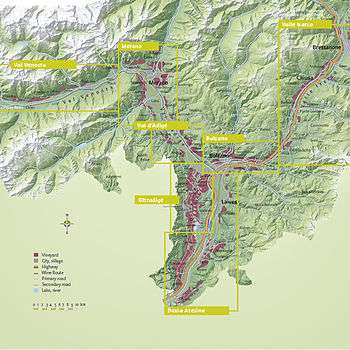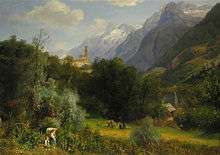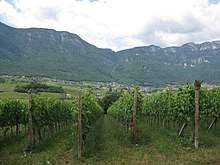South Tyrol wine

South Tyrol is an autonomous province located in north-east Italy producing wine. This Austro-Italian wine region is noted for the distinct Austrian influences on the wine industry due to the region's long history under the rule of Austria-Hungary and Holy Roman Empires.[1]
Because of its unique history and location within the southern Alps and Dolomites, in this region grows a wide range of grape varieties that are not usually seen in other parts of Italy. These include Müller-Thurgau, Vernatsch, Lagrein, Sylvaner, Riesling (known in Italian as Riesling Renano), Gewürztraminer (known in Italian as Traminer Aromatico)[2] and Blatterle.[3]
Winemaking
Winemaking in Tyrol has a long tradition: the first evidences date back to the period before the Romans.
The South Tyrolean wine-growing area is highly influenced by the Mediterranean climate, which in the Adige valley (Überetsch-Unterland, Überetsch, Bozen, Terlan, Burggrafenamt) arrives up to Meran. This allows a very versatile winemaking, which includes almost all the red grape varieties and a lot of white grape wines. The Vinschgau and the Eisacktal have a harsher climate and thus they’re specialized in white wines.
In South Tyrol there are three indigenous varieties: Schiava, Gewürztraminer and Lagrein.
A similar wine growing region is Trentino wine in the south.
History

Findings of seeds dating back to the Iron (Stufels near Brixen) and archaeological findings dating back to 400 BC witness that winegrowing was practised in South Tyrol already 3,000 years ago. Probably the earliest sources date back to before the Romans and to the wine produced by the Rhaetian. Cato the Elder in his De agricoltura highlighted the Rhaetian wine, before the territory was conquered by the Romans. The Romans learned by the Rhaetian how to store and transport wine in wooden barrels (according to Pliny). Especially Augustus and Tiberius (nicknamed “Biberius”) appreciated Rhaetian wine. In 720 AD, under the commissioner Corbinio, first bishop of Freising, vineyards landed in Burggrafenamt. From the twelfth century the monasteries in southern Germania and the aristocrats incentive the winemaking.
In the late Middle Ages and during the Habsburg monarchy the production of wine in the south Tyrolean wineries flourished. The wine production and sale developed thanks to the activity of the families of winemakers from the nineteenth century and thanks to the cooperatives since the twentieth century. In the twentieth century there were several critical periods: first due to the phylloxera and then in the First Post-war with the breakdown of the traditional markets (Austria, Hungary, Bavaria) with the fascist repression, as well as during the Second Post-war. With the mass production, the wine industry consolidated until the 1980s. In the 1980s there was a deep crisis of the sales channels most common at the times, especially the sale of wine in tanks in Switzerland. Cellars changed their sales strategy. More quality wines were produced; quantity moved to the background and nowadays it hasn’t value any longer. Decisive for the wine making in South Tyrol was 1971, when people returned to the division and classification of wine zones according to the PDO rules. The quality production, pursued up until now since 20 years, as well as the spread of the bottling in bottles of 0,75 litres have earned this small wine area an excellent reputation. This is especially true for white wines in Italy, but also for the wine experts in the international markets.
The South Tyrolean Wine Museum in Kaltern offers an overview of the history and the traditional grape cultivation methods in South Tyrol.
Cultivation zones

South Tyrol is a small but faceted winegrowing region. Unique in its field in Italy, it is a region where 20 different grape varieties are cultivated on a land of 13,000 acres, which yelds 50,000 hectoliters (3.9 million cases) of wine. Thanks to its geographical position, between an Alpine climatic zone and a Mediterranean one and with vineyards growing at only 200 meters above sea level and at over 1,000, South Tyrol is Italy’s smallest winegrowing area. It has a high density of PDO wines (Protected Designation of Origin).[4]
The South Tyrolean winegrowing zone is divided into 7 PDO sub-regions:
- “Alto Adige Merano”, around Meran;
- “Alto Adige Val Venosta”, whose vineyards are located west of Meran and south of Adige;
- “Alto Adige Oltradige”, located west of the Eisack into the Adige, and north of the Kalterer See near Terlan;
- “Alto Adige Valle Isarco”, between Vahrn and Völs am Schlern;
- “Alto Adige Colli di Bolzano DOC” south west of Bozen;
- “Alto Adige Santa Maddalena DOC” north west of the previous one.
Among these zones and beyond, there are regions, which produce wines called simply “Alto Adige/Südtirol DOC”. The protected designations of origin rule the labelling of the south Tyrolean wines, according to the origin and guarantee to consumers, resellers and sommelier the source of wine. Approximately 5,000 wine producers deliver their grapes to the 160 wineries, which produce a great variety of wine, red and sparkling wines, despite of their small dimensions. Almost 70% of the south Tyrolean wine is produced in wineries run by social cooperatives, the remaining 25% comes from the association “Alto Adige Estate Wineries”, and the remaining 5% is produced by “Alto Adige Independent Winegrowers”.[5]
Winemaking

Winemaking in South Tyrol is particularly intensive: often involving handwork, on steep terraced slopes, with environment-friendly techniques. Thanks to the so-called “integrated winegrowing”, South Tyrolean farmers strengthen the natural defences of the vineyards, protecting beneficial insects and supporting their spread. Strict limitations of yields and the consistent conversion of the classical pergola to the modern wire frame (Guyot) improved the quality of the grapes.[4]
Varieties
58% of the Alto Adige’s wines are made with white grape varieties: Pinot Grigio, Gewürztraminer, Pinot bianco and Chardonnay are the most common. Also Sauvignon, Müller Thurgau, Sylvaner, Kerner, Riesling and Veltliner are produced.[6]
As regards the red grape varieties, in South Tyrol along with the two indigenous varieties of Schiava and Lagrein all other classic grape varieties have been produced for far more than one hundred years: Pinot nero, Merlot, Cabernet Sauvignon and Cabernet Franc. Nearly 42% of the grape growing area is planted with red wine varieties.[7]
Varieties produced:
- Pinot bianco
- Sauvignon
- Gewürztraminer
- Chardonnay
- Pinot Grigio
- Riesling
- Sylvaner
- Veltliner
- Kerner
- Müller Thurgau
- Moscato
- Schiava
- Pinot nero
- Lagrein
- Merlot
- Cabernet
- Moscato rosa
Literature
translated from:
- Matthias Ladurner-Parthanes: Vom Perglwerk zur Torggl. Athesia, Bozen 1972
- Stocker, Barbara: Der Wein und seine Geschichte. Thaur/Bozen: deleatur, Südtirol in Wort und Bild, 49. Jg., 3. Quartal/2005
- Andergassen, Gotthard: Südtiroler Weinbau und Weinwirtschaft um Mittelalter. Thaur/Bozen: deleatur, Südtirol in Wort und Bild, 49. Jg., 3. Quartal/2005
- Zwerger, Roland: Vom Weißen Lagrein über den „Weißterlinger“ zum Gewürztraminer. Kleine Südtiroler Sortengeschichte mit besonderer Berücksichtigung von Tramin. Bozen: Athesiadruck, Der Schlern 79/2005, Heft 8/9
- Nössing, Josef: Bozens Weinhandel im Mittelalter und in der Neuzeit. Linz: Druckerei R. Trauner, Stadt und Wein, 1996
- Freie Weinbauern Südtirol: . 15. Juni 2007
- Jens Priewe unter Mitarbeit von Christoph Tscholl: Die Weine von Südtirol. Der Guide für Kenner und Geniesser. Collection Rolf Heyne, Ausgabe 2006, ISBN 3-89910-299-1
- Kilchmann, Martin: Weine aus Südtirol. Müller Rüschlikon, 1995, ISBN 3275011685
- Meininger Einkaufsführer: Weine und Winzer aus Südtirol. Meininger Verlag, 2005, ISBN 3-87524-161-4 (PDF)
- Busche Infoguide: Winzer & Weingüter. Deutschland, Elsass, Luxemburg, Österreich und Südtirol. 4. Auflage. Busche Verlag, 2006, ISBN 3-89764-223-9
- Peter Moser: Falstaff Weinguide Österreich Südtirol. 2005/2006. Falstaff-Verlag, ISBN 3-9501628-6-0
- Andreas Otto Weber: Studien zum Weinbau der altbayerischen Klöster im Mittelalter. Steiner, 1999, ISBN 3-515-07290-X
References
- ↑ M. Ewing-Mulligan & E. McCarthy Italian Wines for Dummies pg 109-118 Hungry Minds 2001 ISBN 0-7645-5355-0
- ↑ P. Saunders Wine Label Language pp. 120–212 Firefly Books 2004 ISBN 1-55297-720-X
- ↑ J. Robinson, J. Harding and J. Vouillamoz Wine Grapes - A complete guide to 1,368 vine varieties, including their origins and flavours pg 112 Allen Lane 2012 ISBN 978-1-846-14446-2
- 1 2 Consortium of Alto Adige wine - winemaking
- ↑ http://www.altoadigewines.com/en/wineries.html Consortium of Alto Adige wine - wineries
- ↑ http://www.suedtirolwein.com/us/alto-adige-wines/wines/white-wine-varieties.html White wine varieties in South Tyrol
- ↑ http://www.suedtirolwein.com/us/alto-adige-wines/wines/red-wine-varieties.html Red wine varieties in South Tyrol